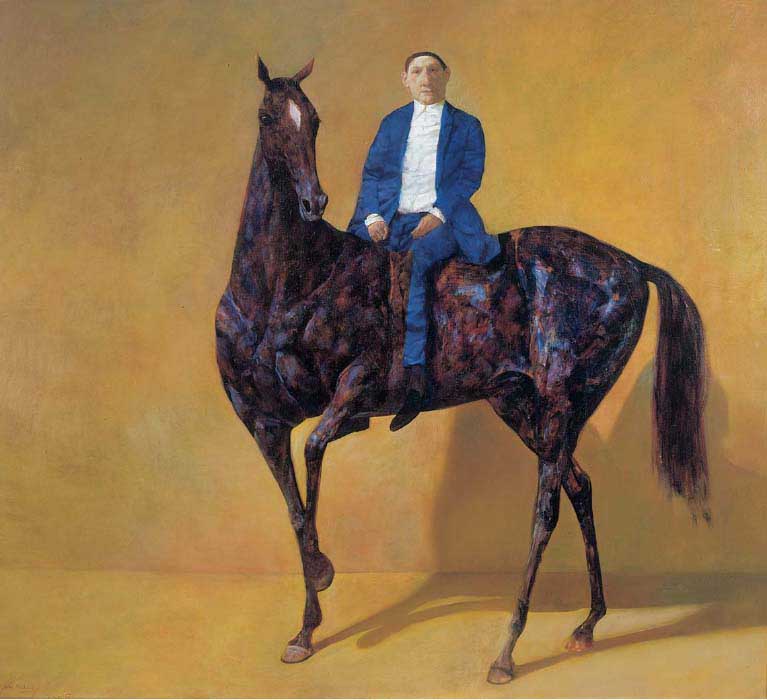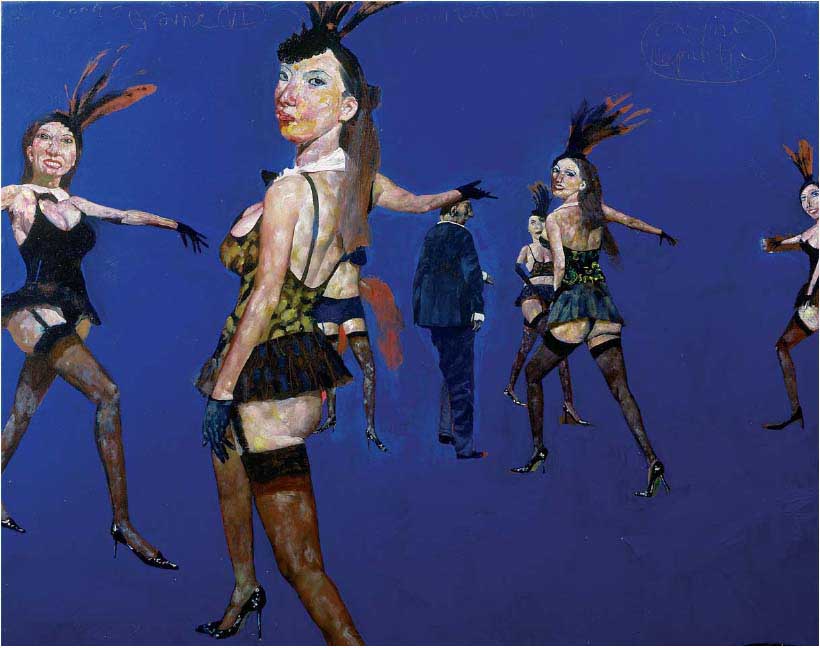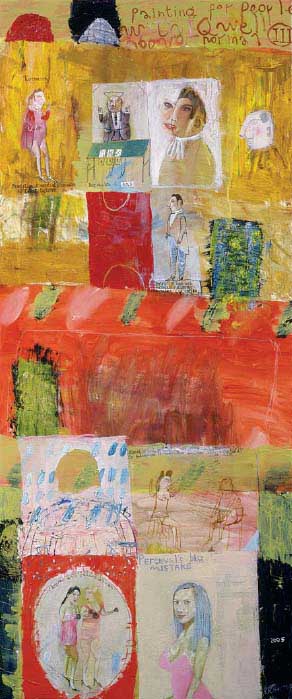Such is the inherent complexity and multifacetedness of Konstantin's work, it is hard to make generic statements that summarize the content or import of the works in a sentence or even a paragraph. What is beyond doubt is that an erudite, highly sophisticated mind is operating behind his work, which is cerebral and witty and both allusive and elusive. The exploration of man's tastes, foibles, dreams and fantasies is conducted through humour, irony, parody and satire. There is always something vaguely disconcerting about the works (like catching one's uncle in frilly knickers and high heels or like a teenager voyeuristically peeping into a strip-club) but they remain totally compelling. Complex in composition and recondite in iconography, the paintings pose an intellectual riddle: indeed, part of the challenge and the pleasure resides in identifying and disentangling the motifs and sources of inspiration. One senses that the cultural well from which Konstantin draws is a deep one: from opera, Berlin cabaret, vaudeville, burlesque, cartoons, newspapers to theatre and costume design. Even the artistic sources of inspiration are multifarious and multilayered: Russian icons, cartoons, ex votos, old master portraits, still life's, trompe-l'oeil and allegorical painting (from Titian to Vermeer, the Fontainebleau School to Matisse, Bosch to Brueghel, Chagall to Picasso). Moreover, the theatricality and parabolic narrative imply affinities not only with Bosch's Ship of Fools but also Hogarth's Rake 's Progress. The literary kinship if not inspiration is similarly complex: from the Old Testament to Erasmus (In Praise of Folly), Brecht, Kafka, Beckett, Ionesco and of course the Masonic libretto of The Magic Flute. It is perhaps Konstantin's love of opera or maybe Russian propagandist art or just awareness of the delights and ambiguities of language (traditore traduttore) that leads him to incorporate words or texts into most of his works: sometimes these are legible and have an explicatory or narrative function, often they are indecipherable, half-erased and bewilderingly opaque, so for most viewers they have only a decorative or aesthetic function - as tantalizing as a fragmentary manuscript. The words can be in the form of printed text, or can be meticulously written, sometimes in a period hand, sometimes scrawled like graffiti or a doodle or a child's scribble - or all combined like a palimpsest. There are libretto texts, ex voto type titles, legal texts, propagandist slogans - and to make these even more enigmatic and inscrutable, they are in Russian, Latin, English, French, German, Portuguese or Chinese. The dramatis personae who strut across Konstantin's stage constitute a colourful medley of characters: gamblers, the décolleté women of the demi-monde, dictators, Banana Republic generals, cowboys, bourgeois, Mafiosi cigar-smokers, angels in the form of paunchy middle-aged men in saggy underpants and wings, sinister men in suits, naked capitalists, liegemen in 18th century court dress, Zorro, Lenin, Marat - and of course the usual kinky habitués of Konstantin's work - the cross-dressers and hookers in fishnet tight and stilettos. Konstantin lives in Macau, the oldest European colony in China, administered by the Portuguese until 1999 and now part of China, famous today for its nightclubs, gambling dens and casinos. The complex ethnic, social and linguistic mix of Macau has no doubt influenced Konstantin but one suspects that much also derives from his own quirky imagination. Almost every work invites careful scrutiny. Even what at first seems like a straightforward portrait of a young man, standing beside a Louis XV armchair and a gaming table, proves, on closer inspection, to be more mysterious. It is, we are told twice, "a portrait of a young man in a middle of something" (sic). In the middle of what, we don't know. The painting abounds with abstruse symbols and obscure shapes: a rectangle with what looks like a sun and a volcano (which reappears elsewhere on the canvas), with the subtitle 'Casino Republic'; fragments of text, half-erased scribbling, scratchings, erasures, vague outlines. Amidst all this stands the young man, cool, detached, with clear eyes and a penetrating gaze. Could this be a symbolic portrait of the artist himself as a young man? Thus Konstantin's work is witty and erudite, a colourful parade of folly, perversity and excess. One suspects a moral lesson there, but Konstantin withholds judgement and remains the inscrutable artist - as James Joyce said, once the artist has finished his work, he should sit back and pare his fingernails. It is up to the viewer to decipher the puzzles. These are highly original, inventive and endlessly intriguing works, deftly painted but much looser in brushwork, more richly coloured and more complex compositionally than much of his previous work. There can be no doubt that they are, to use one of Konstantin's own titles, "paintings for people with an IQ well above normal". TERENCE RODRIGUES Art Historian, Critic & International Art Consultant    |